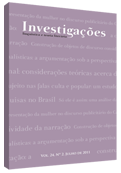Ponto de vista em representação: a construção dos objetos de discurso em reportagens de revista feminina
Abstract
A representação de pontos de vista em diferentes gêneros do discurso põe em evidência fenômenos de heterogeneidade enunciativa. Essa heterogeneidade conduz-nos a focalizar a dimensão dialógica do ponto de vista. Assim, a relação do sujeito com as instâncias que povoam o seu discurso pode ser analisada a partir dos objetos de discurso, já que a construção desses objetos homologa traços do diálogo interior do locutor com ele mesmo e com os outros. Ao focalizar as relações que o locutor nutre com os enunciadores, analisaremos como se dá a representação de pontos de vista em reportagens de revista feminina.References
APOTHÉLOZ, D. ; REICHLER-BÉGUELIN, M.-J. 1995. Construction de la référence et stratégies de désignation. Travaux Neuchâtelois de Linguistique 23: 9-39.
AUTHIER-REVUZ, J. 2004. La représentation du discours autre: un champ multiplement hétérogène. In : Juan Manoel Lopez-Munõz; Sophie Marnette & Laurence Rosier, éds. Le discours rapporté dans tous ces états. Paris: Harmattan. p. 35-53.
KOCH, I. 2002. Desvendando os segredos do texto. São Paulo: Cortez.
CUNHA, D. 2008. Do discurso citado à circulação dos discursos: a reformulação bakhtiniana de uma noção gramatical. Matraga 22: 129-144.
______. 2009. Circulação, reacentuação e memória no discurso da imprensa. Bakhtiniana 1(2): 23-39.
DOURY, M. 2004. La fonction argumentative des échanges rapportés. In: Juan Manoel Lopez-Munõz; Sophie Marnette & Laurence Rosier (Eds.). Le discours rapporté dans tous ces états. Paris: Harmattan. p. 255-264.
MARCUSCHI, L. A. 1997. Citação de fala na interação verbal como fala idealizada. Actas del I Colóquio Latinoamericano de Analistas del Discurso. Caracas: Editora de la Universidad de Venezuela, Vol. 1. pp. 107-201.
RABATEL, A. 2004. La déliaison des énonciateurs et les locuteurs dans la presse satirique. Langage et Société 110: 7-23.
______. 2005. La part de l’énonciateur dans la construction interactionnelle des points de vue. Marges linguistiques 9: 115-136.
______. 2006. Du rôle des postures énonciatives de surénonciation et de sousénonciation dans les analyses de corpus. L’exemple des reformulations, des connecteurs et particules discursives. In: M.-C. Guernier; V. Durand-Guerrier; J.-P. Sautot (Eds.). Interactions verbales, didactiques et apprentissages. Recueil, traitement et interprétation didactiques des données langagières en contextes scolaires. Besançon: Presses Universitaires de Franche-Comté. p. 221-248.
______. 2008. Homo narrans. Pour une analyse énonciative et interactionnelle du récit. Tome 1. Les points de vue et la logique de la narration. Limoges: Editions Lambert-Lucas.
______. 2009. Prise en charge et imputation, ou la prise en charge à responsabilité limitée. Langue Française 162: 71-87.
ROSIER, L. 2008. Le discours rapporté en français. Paris: Ophrys.
TORCKY, D. 2004. Ancrage interactionnel du DR en conversation et double contraite. In : Juan Manoel Lopez-Munõz; Sophie Marnette & Laurence Rosier, (Eds.). Le discours rapporté dans tous ces états. Paris: Harmattan. p.245-253.
Downloads
Published
How to Cite
Issue
Section
License
Copyright (c) 2011 Suzana Leite Cortez

This work is licensed under a Creative Commons Attribution 4.0 International License.
Authors who publish with Revista Investigações agree to the following terms:
Authors retain copyright and grant the journal right of first publication with the work simultaneously licensed under the Creative Commons Attribution 4.0 International (CC BY 4.0) license that allows others to share the work with an acknowledgement of the work's authorship and initial publication in this journal.
Authors are able to enter into separate, additional contractual arrangements for the non-exclusive distribution of the journal's published version of the work (e.g., post it to an institutional repository or publish it in a book), with an acknowledgement of its initial publication in this journal.
You are free to:
Share — copy and redistribute the material in any medium or format for any purpose, even commercially.
Adapt — remix, transform, and build upon the material for any purpose, even commercially.
The licensor cannot revoke these freedoms as long as you follow the license terms.
Under the following terms:
Attribution — You must give appropriate credit , provide a link to the license, and indicate if changes were made . You may do so in any reasonable manner, but not in any way that suggests the licensor endorses you or your use.
No additional restrictions — You may not apply legal terms or technological measures that legally restrict others from doing anything the license permits.

